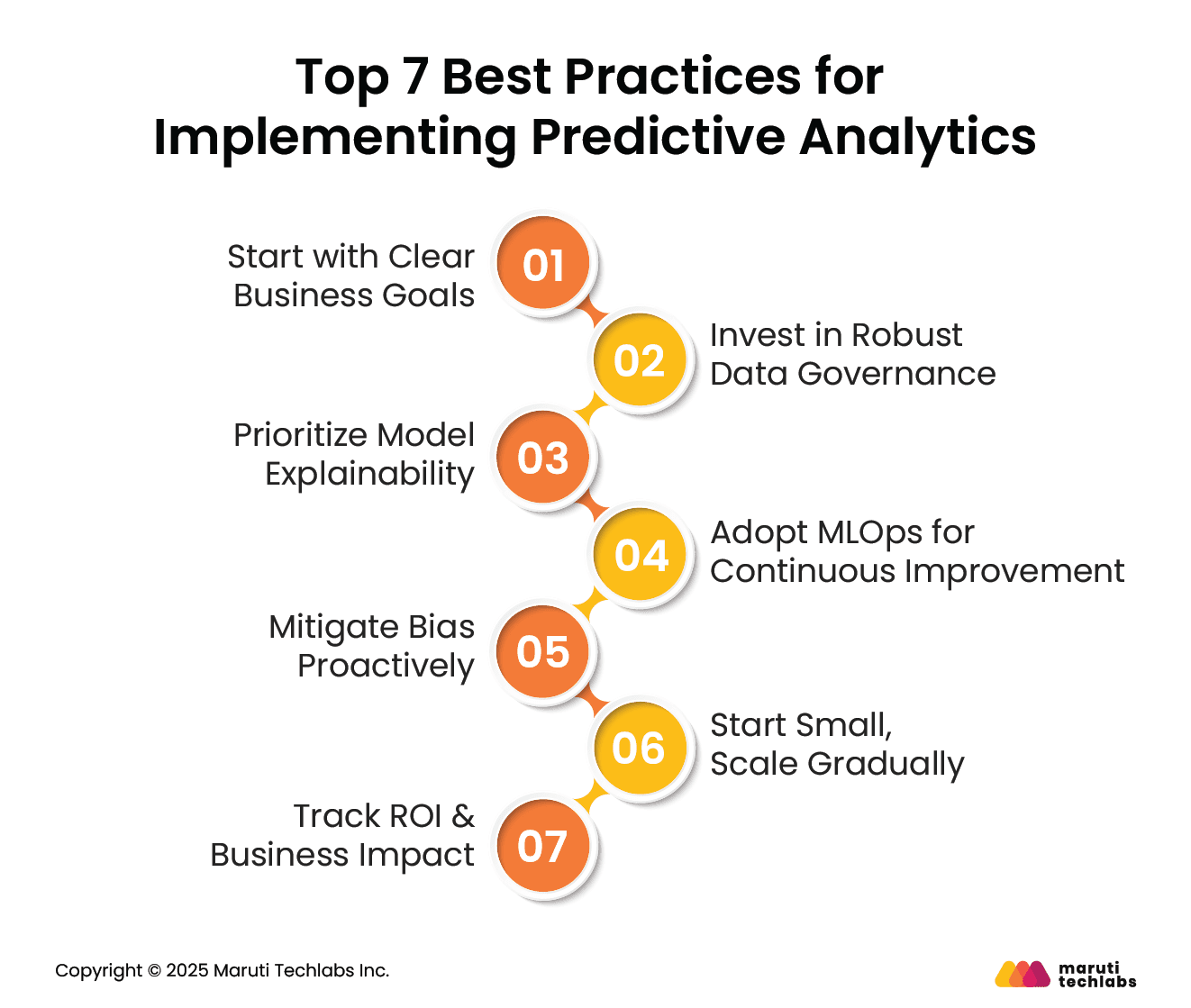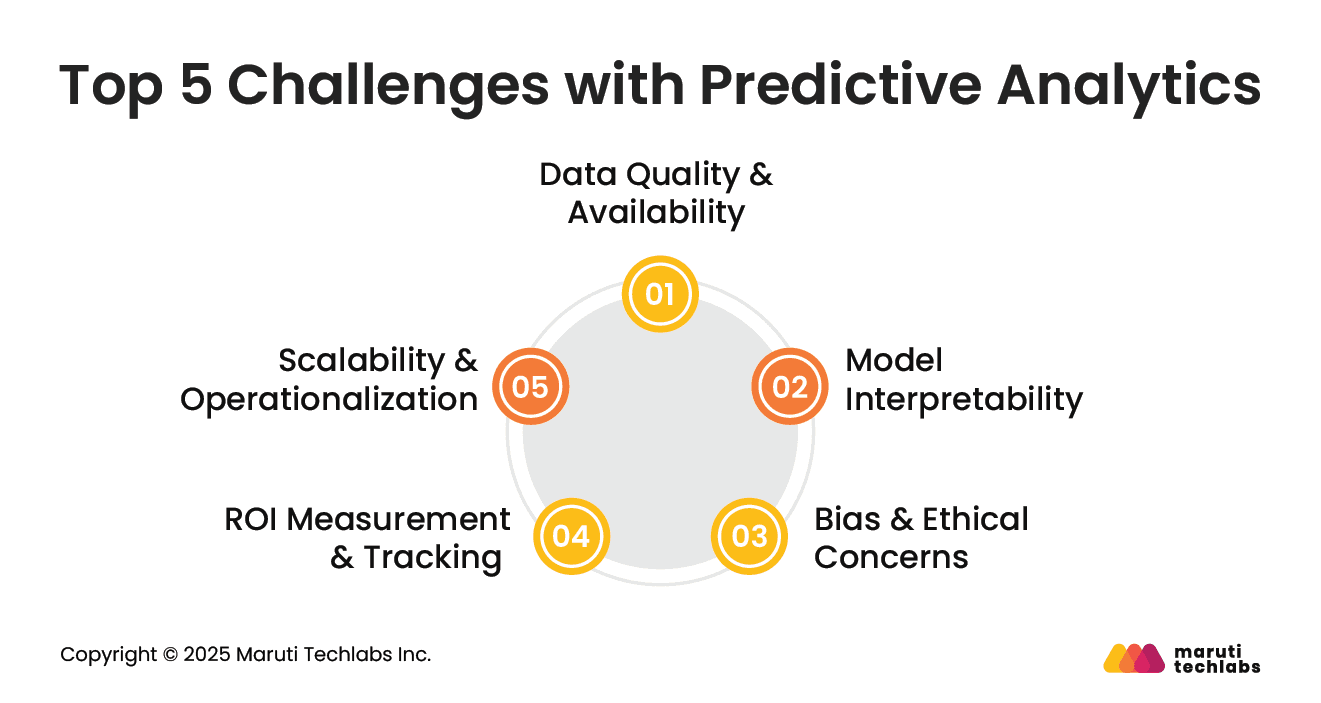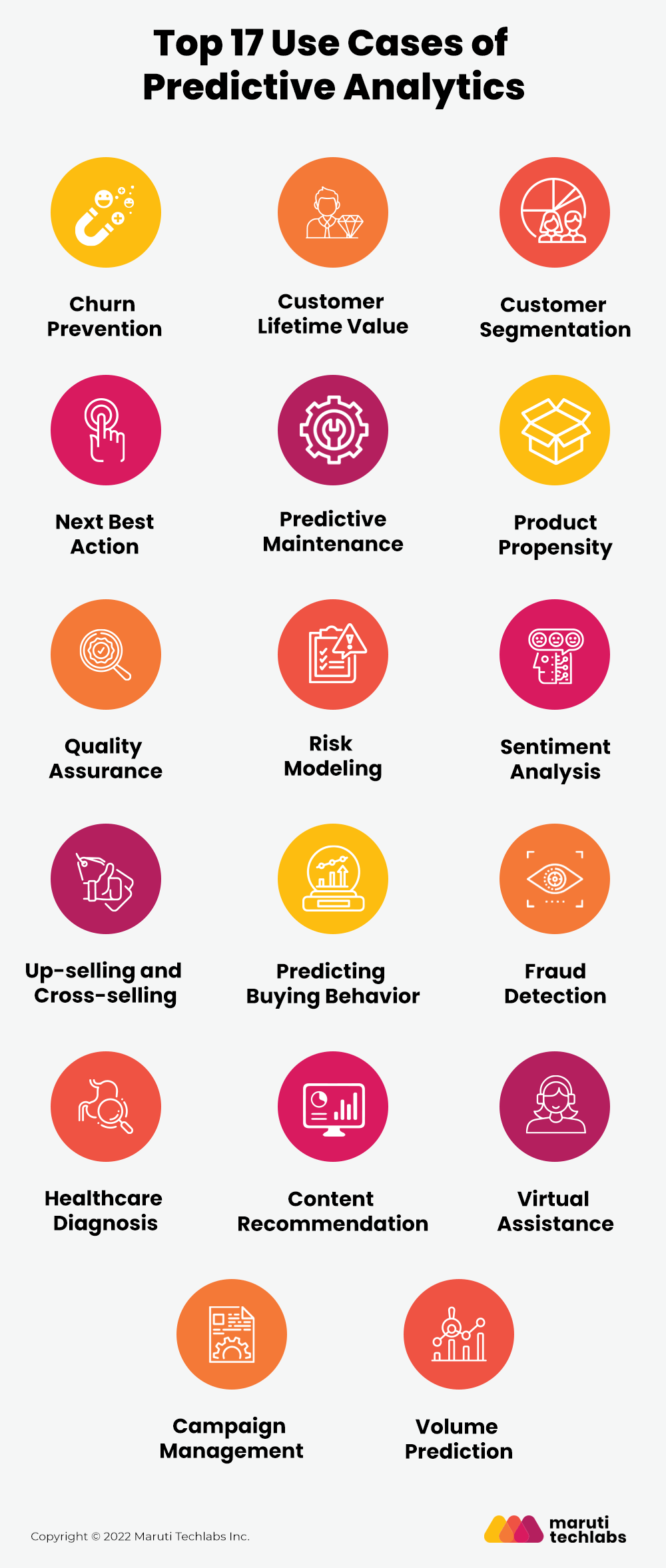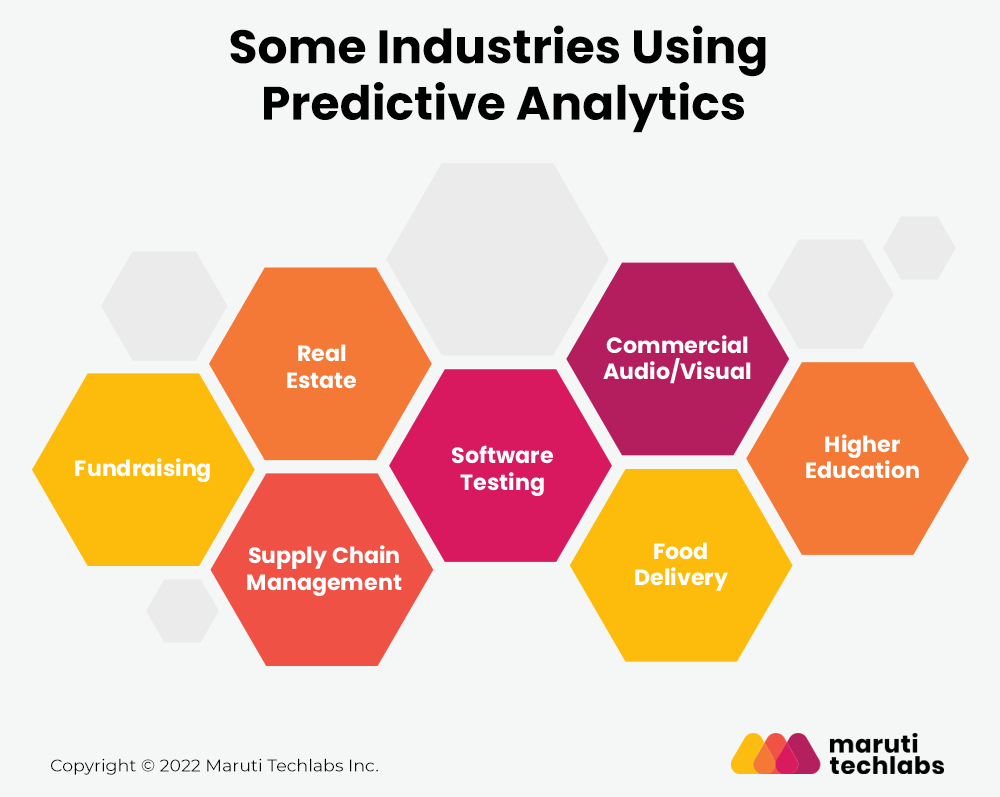

17 Predictive Analytics Use Cases Transforming Industries Today






Predictive analytics transform operations by using historical and real‑time data to forecast future trends, risks, or behaviors, turning insight into proactive decision‑making.
Organizations leveraging these tools gain a powerful competitive edge: they reduce downtime through predictive maintenance, optimize supply chains by anticipating demand, detect fraud faster, and personalize customer experiences. This predictive foresight helps companies stay agile, efficient, and ahead in fast‑paced markets.
In healthcare, predictive models help identify readmission risks and forecast disease outcomes using EMR data. Legal firms are adopting analytics to predict case outcomes and spot compliance issues. Retail, banking, finance, insurance and manufacturing use prediction to forecast demand, detect fraud, optimize inventory, price products dynamically, and plan maintenance
This article covers 17 real‑world examples of predictive analytics in operations. We’ll also explore emerging trends, challenges and best practices for successful implementation.
As predictive analytics enters 2025, its evolution is driven by AI-native tools and cloud‑based architectures. Businesses increasingly rely on builtin forecasting models, data‑streaming pipelines, real‑time anomaly detection, and agentic AI to derive proactive insights from growing, complex datasets.
Here are 6 such trends to keep in mind.
Google’s BigQuery ML now includes the TimesFM model, a pre‑trained transformer for time‑series forecasting that works zero‑shot on unseen data. Combined with ARIMA_PLUS, it lets analysts run scalable, accurate forecasts directly in SQL, no external model training required, simplifying workflows and reducing deployment friction.
Cloud‑native AI platforms such as BigQuery, Microsoft Fabric, Snowflake, and Databricks are transforming predictive analytics by providing serverless scalability, integrated machine learning, and automated data pipelines.
They unify data lakes and warehouses, breaking down silos to enable real‑time insights and operational agility. Their native ML capabilities allow organizations to deploy predictive models closer to the data, reducing latency and accelerating decision‑making.
Agentic AI systems, “AI coworkers”, can plan, execute, and adapt multistep workflows autonomously, surfacing predictions, anomalies, and recommendations in real time to users. These agents transform analytics into proactive operational support, bridging data with execution and reducing manual oversight.
The shift toward continuous data streaming enables predictive analytics to act instantly, identifying anomalies, forecasting trends, and triggering alerts automatically. This capability is pivotal for use cases like fraud prevention, IoT monitoring, and just‑in‑time supply chain decisions.
Generative AI, including retrieval‑augmented generation (RAG), is enhancing predictive analytics by enabling natural‑language insight generation, automated scenario modeling, and context‑aware forecasts that blend structured data with external knowledge.
Platforms combining data lakehouse architecture with built-in AI like Microsoft Fabric, Lakehouse in BigQuery, and Snowflake, support unified storage and predictive model operations. This trend streamlines management, improves data governance, and accelerates insight-to-action scales.
In simple terms, predictive analytics helps to predict future trends and patterns using historical data. It uses different data patterns and identifies the correlations between the variables. It helps to reduce business risks and costs by predicting the future values of certain variables.
For instance, the organization can determine the profits for the coming months by analyzing the output and revenue of the company. The model focuses on two variables; one is dependent while the other is independent.
There are numerous predictive analytics models such as classification models, clustering forecasts, time series, etc. These models help predict future variables based on the insights and data arranged in multiple ways.
Here are top 10 key benefits of predictive analytics,
Implementing predictive analytics involves a structured process that transforms raw data into actionable insights. Here how you can do this following these 4 essential steps.
Gather historical and real-time data from various sources such as databases, sensors, CRM systems, or EHRs. Ensure data quality and completeness.
Clean, normalize, and transform the data. Choose appropriate statistical or machine learning models (e.g., regression, decision trees, neural networks) to train and validate predictions.
Use platforms like Python, R, SAS, IBM SPSS, or cloud-based services like AWS SageMaker, Azure ML, or Google Cloud AI for development and deployment.
Interpret the model results to generate forecasts, identify patterns, and support decision-making. Integrate outputs into business workflows or dashboards for real-time action.

Predictive analytics empowers organizations to anticipate trends, mitigate risks, and optimize operations. Yet, its effectiveness depends on overcoming technical, operational, and ethical challenges that can affect accuracy, trust, and business adoption.
Predictive models rely heavily on high-quality, complete, and timely data. Inconsistent, siloed, or missing data can compromise model performance, leading to unreliable forecasts.
Organizations must implement strong data governance, ensure proper integration across sources, and continuously monitor data pipelines to maintain the reliability of insights.
Many advanced predictive models, especially deep learning-based, act as “black boxes,” making their predictions hard to explain. Lack of transparency can hinder stakeholder trust and adoption.
Implementing explainable AI (XAI) techniques and visualizations helps decision-makers understand the reasoning behind predictions and comply with ethical or regulatory requirements.

Predictive analytics can unintentionally reinforce biases present in historical data, resulting in unfair or discriminatory outcomes. This is particularly critical in sectors like finance, healthcare, or hiring.
Proactively identifying, auditing, and mitigating bias during model development and monitoring ensures fairness and supports ethical, responsible AI adoption.
Demonstrating the business impact of predictive analytics initiatives can be challenging. Without clear KPIs and performance benchmarks, organizations struggle to track ROI or secure stakeholder buy-in.
Establishing measurable objectives, monitoring predictive performance against outcomes, and translating insights into tangible operational gains are key to long-term success.
Even accurate predictive models can fail if not effectively deployed into production. Challenges include integrating models with existing systems, scaling to handle large data volumes, and maintaining performance over time.
Adopting MLOps practices and cloud-native pipelines ensures smooth deployment, ongoing monitoring, and seamless model updates.
Feature | Predictive Analytics | Traditional BI |
| Purpose | Forecasts future trends and outcomes | Analyzes historical data for insights |
| Data Usage | Uses current and historical data for predictions | Focuses mainly on historical data |
| Techniques Used | Machine learning, statistical modeling | Dashboards, reporting, OLAP |
| Outcome | Proactive decision-making and risk mitigation | Descriptive insights and performance tracking |
| User Interaction | Often automated, with minimal manual intervention | Heavily dependent on user queries and manual setup |
| Value Generation | High value through foresight and action recommendations | Value from hindsight and performance summaries |
Today, businesses regularly use predictive analytics to analyze the target customer to gain operational results. The list of predictive analytics applications in various industries is never-ending. Therefore, below are some of the everyday examples for predictive analysis in multiple domains:

When a business loses a customer, it has to replace the loss of revenue by bringing a new customer. It proves to be expensive as the cost of acquiring a new customer is much higher than retaining the existing customer.
Predictive analytics models help prevent churn in your customer base by analyzing the dissatisfaction among your current customers and identifying customer segments at most risk for leaving. Businesses can make the necessary modifications using predictive data to keep customers happy and satisfied, eventually protecting their revenue.
Key Industries: Banking, Telecommunications, Retail, Automotive, Insurance
It is pretty challenging to identify the customer in the market who is most likely to spend large amounts of money consistently over a long period.
This kind of data through predictive analytics use case allows the business to optimize their marketing strategies to gain customers with the most significant lifetime value towards your company and product.
Key Industries: Insurance, Telecommunications, Banking, Retail
Customer segmentation enables you to group the customer by shared traits. Different businesses determine their market differently depending on the aspects that offer the most value to their company, products, and services.
Profound use of predictive analytics techniques helps target the markets based on accurate insights and indicators and analyze the segments of those most interested in what your company offers. Using these predictive analytics applications, you can make data-driven decisions for each part of your business. The same data also enables you to potentially identify the entire markets that you didn’t even know existed.
Key Industries: Banking, Pharmaceutical, Automotive, Retail, Insurance, Telecommunications, Utilities
Determining your primary marketing goals and customers is a critical use case for predictive analytics. It only provides an incomplete picture of what your marketing approach should be.
Predictive data analytics is the best way to approach such individual customers within given segments and analyze everything, from buying patterns to customer behavior and interactions, which offers you insights into the best times and modes to connect those customers.
Key Industries: Banking, Telecommunications, Insurance, Education
In businesses, maintaining costs plays an essential role in increasing revenue. It is difficult for an organization with a significant investment in equipment and infrastructure to manage capital outlay. It’s where predictive maintenance machine learning techniques come in.
By analyzing the insights and metrics of the maintenance cycle of technical equipment, companies can set timelines for maintenance events and upcoming expenditure requirements by streamlining the maintenance cost and downtime. You can simplify your maintenance costs by performing actions that can increase the lifespan of your equipment.
Commonly, most systems become inoperable during maintenance. This is an example of predictive analytics that determines the best time to perform maintenance to avoid lost revenue and dissatisfied customers.
Key Industries: Automotive, Logistic & Transportation, Oil & Gas, Manufacture, Utilities
Product propensity combines purchasing activity and behavior data with online behavior metrics from social media and e-commerce. It enables you to identify the customer’s interest in buying your product and services and the medium to reach those customers.
It helps to correlate the data to provide insights from different campaigns and social media channels for your business services and products. Predictive analytics applications never fail to maximize those channels that have the best chance of producing significant revenue.
Key Industries: Banking, Insurance, Retail
Quality assurance is a key to your customer experience and the bottom line of all your operational expenses.
Ineffective quality control will affect your customer satisfaction scale and ultimately impact the revenue and market share. Also, it leads to more customer support costs, warranty issues, and repairs for inefficient manufacturing. Industries using predictive analytics use cases can provide insights into potential quality issues and trends before they become critical.
For example, predictive analytics can help identify high-risk modules in your application, prioritize critical areas, and reduce time to market through shift-left testing. With predictive analytics, your approach to QA shifts from reactive to proactive.
Key Industries: Pharmaceutical, Manufacturing, Automotive, Logistics and Transportation, Utilities
Prevention and prediction are two sides of the same coin. Risk comes in various forms and initiates from a variety of sources. Predictive analytics can draw potential risk areas from significant data insights collected from most organizations.
It sorts them to analyze the potential risks and suggests the development of situations that can affect the business. By combining the results of the predictive analytics applications with the risk management approach, companies can evaluate the risk issues and decide how to mitigate those risk factors.
For instance, health organizations generate risk scores to identify the patients who might benefit from enhanced services, preventative care, and wellness consultations.
Key Industries: Banking, Manufacturing, Automotive, Logistics and Transportation, Utilities, Oil and Gas Utilities, Pharmaceuticals
In this era of the online world, it is difficult to be everywhere at all times. Reviewing and capturing everything said about your business or organization is virtually impossible.
However, by crawling tools with customer posts and feedback, you can create analytics that can give you a clear picture of your business reputation within the market. Predictive analytics models provide you with proactive recommendations as the best way to enhance that reputation.
Key Industries: Pharmaceutical, Education, Retail, Telecommunications, Insurance, Entertainment
The customer base is the source of your business’s existing revenue and revenue growth. Eventually, maximizing the possible revenue opportunities within your product set and target market segment becomes critical.
Purchasing history data can be utilized to determine which goods and services might benefit from being offered together. Predictive analytics use case provides suggestions on market segments to increase your customer value and revenue derived from your customer. The business sales are raised, and your customer walks away with items that work together.
Key Industries: Banking, Retail, Telecommunications, Insurance, Ecommerce

One of the best examples of predictive analytics is analyzing customers’ buying behavior in retail industries. Companies use advanced analytics to identify buying behavior via customers’ purchase history.
E-commerce retailers incorporate predictive analytics in PoS to predict customer purchase patterns. Walmart is a great example. It uses early data insights to understand buying behavior in certain circumstances, which helps you understand the customer on a personalized level.
Key Industries: E-commerce, Retail, Banking, Insurance
Cybersecurity is becoming a growing concern in today’s era, and there are plenty of examples of predictive analytics in this domain. The most important out of all is fraud detection. The predictive analytics application helps analyze the system’s anomalies and detect unusual behaviors and patterns to determine threats.
The basic idea for this process is to make use of predictive AI. It limits hackers’ entry and vulnerabilities that might put the system at risk. For example, experts input the historical data of cyber attacks and threats to the predictive analytics algorithms, and when it identifies something similar, it will notify the respective personnel.
Key Industries: Banking, Telecommunications, Automotive
The healthcare industry benefits the most from the use cases for predictive analytics health data is critical to diagnose depending on the patient’s history and current illness. The predictive analytics model enables you to understand the disease by making an accurate diagnosis based on past data provided. Health organizations leverage this prediction to ensure patients get the needed treatment.
Keeping in mind the critical health factors, doctors can reach the root cause of the disease. For example, predictive analytics helps doctors identify patients at risk for certain adverse health conditions. It provides them with timely analytics to start working on treatment early, avoiding severe issues in the future. Predictive analytics applications can assist in stopping the spread of adverse health effects.
Key Industries: Health sectors, Pharmaceuticals
Additional Read – Applications of Machine Learning in Healthcare

Content recommender systems are one of the most famous examples of predictive analytics. Entertainment companies can easily predict what users want to watch based on their watch history and predictive analytics techniques.
For instance, Netflix utilizes the predictive analytics algorithm to recommend the content to the user based on their genre, keywords search, ratings, and more.
Key Industries: Entertainment, Retail, Ecommerce
Combined with the power of deep learning models, predictive AI works wonders when utilized with virtual assistance. Ok Google, Alexa, and Siri are real-world predictive analytics examples. Companies use virtual assistants that can act as chatbots. These virtual assistants learn and collect user behavior data and deliver accurate results.
It helps to improve customer experience because these bots train themselves from interactions and predict customer response. As they are self-learning, companies can better manage customers without hiring many support staff.
Key Industries: Automotive, Ecommerce, Telecommunications
Predictive analytics applications can help you determine where your campaign is best focused. A campaign launched using email work well as a suggestion at check out or, your customer is turning to your website for information. The analytics tools like word clouds generated from call recording data help you analyze the outreach efforts.
Key Industries: Telecommunications, Retail, Automotive
By analyzing the fluctuations in the volume, you can severely impact how well you serve your customers. If you predict the increase in inbound volume, you can easily manage the effect of such changes. You can ensure your facilities can be adequately staffed if you know when spikes will occur.
For example, one of the predictive analytics applications for insurance companies is to predict the patterns in plans used for specific providers or demographics. These patterns can further make adjustments to claim workflow and adjust the processes for seasonality.
Key Industries: Insurance, Entertainment, Telecommunications, Banking

Predictive analytics tools make assembling your data and improving your processes easy. Other than the industries mentioned above, some domains apply predictive analytics use cases as a core operating strategy. Below are some commonly used examples of predictive analytics that have proven to enhance business growth for specific industries:

Fundraising depends on the intelligent use of provided data and good old-fashioned relationship building with other organizations in the market. Identifying who to connect with and how to connect with them gives you an edge to leg up and remove the procedure.
Predictive modeling enables you to plan a fundraising strategy and ensure the proper communication with the right people at the right time. Rather than sending the generic appeals, predictive analytics use cases break your donor base down into actionable, and targeting your outreach will save your time and money, eventually leading you to a higher success rate. Fundraising data analyses also help you track your success rate with various fundraising efforts.
Rooled helps startups understand investor behavior and optimize their fundraising efforts. Their predictive analytics model helps learn key areas that appeal to potential investors, enabling them to tailor their pitches accordingly.
Real estate is an industry domain where data is in demand. Predictive analytics use cases enable real estate brokers to provide buyers with projected home values. Real estate analytics is the significant value-add that agents can offer their clients. In the age of overabundance agents, it is an easy way to distinguish yourself.
Predictive analytics match the ready and able buyers with the property sellers who are quite ready to list their properties. The only extra effort you may need is to convince the seller it’s time to get their property on the market.
Zillow leverages predictive analytics in its Zestimate feature, offering estimates based on a mix of data points, such as historical sales data, tax assessments, and geography. This helps sellers and buyers understand market trends and make informed decisions.
Predictive analytics models simplify analyzing huge amounts of data generated during software testing. Predictive analytics use cases help improve the efficiency of the operation throughout the software testing life cycle. You can keep track of your schedule by monitoring the timelines using predictive modeling and analyzing how delays impact your project.
Predictive analytics use case helps to analyze your customers’ mood by social media trends and allows you to get ahead in the market. Instantly measuring the customer experience, insights, and opinions, you can forecast these data and generate immediate feedback to use in your bug-fixing process. Your defect detection and test efficiency improve when you implement predictive analytics use cases.
Lambda Test analyzes user behavior patterns using predictive analytics and optimizes browser testing. Using usage statistics, it develops a more effective testing strategy for specific devices and browsers.
When it comes to Pro AV, insights allow you additional operational improvements in every aspect of the business. Predictive analytics applications open the door to new sources of revenue by featuring the market sectors that you may not be aware of. The insights strengthen your marketing campaign and highlight your customers’ needs in year-based events, conferences, and functions.
The predictive analytics tools enhance your customer service by providing faster and more accurate insights according to your customers’ needs and practices. Applying predictive analytics in your Pro AV operations will provide you with a significant edge over competitors who are not taking advantage of opportunities. Through modern devices, which are “always-on” and “always connected,” you can leverage a constant data stream to feed your predictive models. It means that your model will depend on the most up-to-date information.
Sound with vision merges predictive analytics with audio and video conferencing systems, digital signage, and interactive whiteboards. They focus on offering seamless and reliable performance tailored to clients, leveraging data to predict and optimize performance and client engagement strategies.
Poorly developed supply chains eventually affect every area of business. You can improve your supply chain by gathering as much information up-to-date as possible using predictive analytics use cases and making all your decisions based on accurate, up-to-the-minute information instead of dated reports.
Predictive data can help you be much more agile in your decision-making since it will help you analyze the impact of various variables on your supply chain’s efficiency. Identifying the least efficient areas of your supply chain and making projections to improve their impact allows you to correct the issues before they take effect. It will also help you with a great deal of saving over a long time as your supply chain becomes more efficient.
DHL has implemented predictive analytics to enhance its supply chain and logistics operations. DHL can predict shipment delays, optimize delivery routes, and effectively manage inventory by analyzing historical and real-time data.
Click here to read the use cases of machine learning in supply chain management.
The food delivery industry is a thriving sector in today’s market. Everything is quantifiable in this domain, be it delivery times, zip codes, prices, or customer satisfaction. This data can be processed to improve operations and profits while cutting costs.
GrubHub, one of the most prominent players in this domain, uses demographic data to make smart predictions about what offering might lure their customers. Similarly, the other competitor DoorDash focuses on the relationship between the time variables like time of day, time of weekends, etc., to predict when the customer will be more likely to wait for their food.
Other companies also focus on predictive data like how many drivers they will need or incentives to offer when drivers are in demand. They also predict customer satisfaction over the particular items to analyze which food item is most likely to be in high demand soon.
Using predictive analytics, Uber Eats improves order accuracy and optimizes forecast demand and delivery times. It also predicts peak ordering times, increases driver availability, and optimizes delivery routes by analyzing historical data.
Use cases for predictive analytics in higher education include management, retention, fundraising, and retirement. In all these domains, predictive analytics provides intelligent insights that give you an edge over others.
The predictive analytics application can score each student based on their high school data and inform the administrators on how to support them over their courses best. Predictive analytics provide fundraisers with important information about the best methods and times to reach donors.
With the data provided, the recruiters can accurately target their outreach to lead to success at the minimum cost. This predictive analytics use case can help us understand what factors persuade the students to stick to their original school and not transfer to another.
Georgia State University has tracked over 140,000 student records and millions of grades and discovered myriad factors in student attrition. Their models send alerts when students are at risk with timely interventions that have increased graduation rates amongst at-risk minority and first-generation students.
We have implemented predictive analytics solutions for clients across verticals. One such client belongs to the automotive industry. The client is a used car selling company with a buyer network spread across the United States.
The client faced challenges in accurately predicting monthly sales numbers for different car makes and models. The existing statistical model used to predict monthly average sales failed to capture non-linearity and time series of the buyer patterns of vehicles across the US market.
Our data scientists worked with a variety of datasets, ran them against algorithms, and analyzed the efficiency of each algorithm. We switched from the existing model, i.e., Manual Linear Regression, to other Machine Learning models to automate seasonality prediction of different car makes.
The models are as follows:
Results of ensembled ARIMA and RNN were significantly better than those of the previous models.
Using predictive analytics to better understand the impact of seasonal trends on our client’s overall sales helped accelerate their sales cycles. The client was able to form more informed sales strategies and identify new opportunities using automated seasonality prediction.
Building predictive analytics applications requires a teamwork approach. You need a team that understands your business goals and realizes the potential of your existing data. As a part of our machine learning services, we combine data analytics and business insights and build intelligent self-learning systems that help you understand your target audience, spot hidden threats, and grab new opportunities.
Using the right tools and technology, we bring to life your vision of predicting market trends, buying patterns, and future changes that might affect your business. To make better business decisions based on data, reach out to us here.
Although these examples of predictive analytics showcase that it can predict future outcomes, you don’t have to dive headfirst with it. You can initiate with a small segment of your organization and test the predictive analytics tools to see how it works. If you see results, you can build them across other segments of your business.
But the question is, what do you need to get started using predictive analytics? The answer to this question is divided into four parts. The first thing you need is to identify the problem you are trying to solve using predictive analytics. For instance, what do you want to know about the future based on the data? What decision will be made using these predictions?
The second thing you need is relevant data to be processed. Your business needs to analyze the abundant data to draw out the predictions. The third aspect is that you need someone who understands both the data and the business problem. How you interpret the data is essential to making important decisions that’ll lead to your business success.
As the demand for AI integration grows, companies seek specialized artificial intelligence consulting services to ensure seamless implementation.
The next step is to build a predictive analysis model. You’ll need an expert team that can use advanced technology like machine learning to get more out of your data. A machine learning solutions provider can refine your models better and provide the best performing predictive analytics models and algorithms for your business.
AI enhances predictive analytics by enabling models to learn patterns from vast datasets and generate highly accurate forecasts. Machine learning algorithms automate trend detection, while deep learning supports complex predictions in areas like demand forecasting, fraud detection, healthcare outcomes, and personalized customer recommendations.
ChatGPT is primarily a generative AI model, not a predictive analytics tool. While it predicts the next word in a conversation, it does not analyze historical business data to forecast trends or outcomes in the way predictive analytics systems are designed.
Netflix applies predictive analytics to personalize recommendations and optimize content strategies. By analyzing viewing history, user behavior, and engagement patterns, its models predict what a viewer is likely to watch next, guiding content promotion, production decisions, and improving overall user experience.
A common application is demand forecasting, where organizations predict product or service demand to optimize inventory, staffing, and resource allocation. Other widespread uses include fraud detection, predictive maintenance, risk scoring, and customer churn prediction, helping businesses proactively respond to future scenarios.


